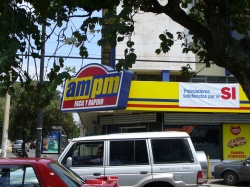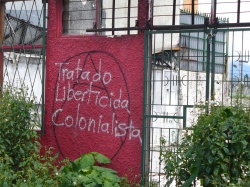On Sunday, October 7, Costa Rica’s voters approved the entry of the state into the Central American Free Trade Agreement (CAFTA) with their first-in-history vote by referendum. In Costa Rica, the agreement was known as TLC, or, Tratado Libre Commercio (Free Trade Treaty) and was hotly contested, publicly fought, and barely passed.
The dramatic enactment of democracy in Costa Rica barely made a stir in United States news agencies. For instance, the Washington Post published one short article on October 8, page A-11, dateline: Mexico City, with the results of the vote. Other local news in states with large textile concerns were a little more interested–many in the U.S. believe that CAFTA will continue to take manufacturing jobs away from U.S. labor. But I was there and can write a little about the conduct of the controversy. The photos below (not the map, which is from NPR) I took this month.
CAFTA/TLC
 The Central American Free Trade Agreement is a burgeoning economic community in the Western Hemisphere. Its member countries are: the United States, El Salvador, Honduras, Nicaragua, Guatemala, and the Dominican Republic–and now, Costa Rica. Because the Dominican Republic is considered Caribbean rather than Central American, the agreement is sometimes called by the acronym DR-CAFTA or CAFTA-DR. It is a counterpart of sorts to the North American Free Trade Agreement (NAFTA) between Canada, the U.S. and Mexico. Belize and Panama are not signatories to the agreement.
The Central American Free Trade Agreement is a burgeoning economic community in the Western Hemisphere. Its member countries are: the United States, El Salvador, Honduras, Nicaragua, Guatemala, and the Dominican Republic–and now, Costa Rica. Because the Dominican Republic is considered Caribbean rather than Central American, the agreement is sometimes called by the acronym DR-CAFTA or CAFTA-DR. It is a counterpart of sorts to the North American Free Trade Agreement (NAFTA) between Canada, the U.S. and Mexico. Belize and Panama are not signatories to the agreement.
The Caribbean states also have their own trade agreement (in which the U.S. is not a signatory), but (as stated earlier) only the Caribbean’s Dominican Republic is a signatory to CAFTA.
The case for Free Trade
 A free trade agreement allows states to lower tariffs between each other and can be bilateral or multilateral. Currently, a network of free trade treaties, both bilateral and multilateral, link states of the Western Hemisphere to each other, but they differ in membership and content. Increasing numbers of multilateral ties both reflect and facilitate the rise of global markets. Under these agreements, states are given better access to each other’s markets and can export and import more easily. For Costa Rica, this may enable an influx of engineering and technical assistance, serve to modernize its business management, and streamline its markets for agricultural products–both crops and value-added agricultural merchandise. It may also add to the job pool for labor, both skilled trades and unskilled.
A free trade agreement allows states to lower tariffs between each other and can be bilateral or multilateral. Currently, a network of free trade treaties, both bilateral and multilateral, link states of the Western Hemisphere to each other, but they differ in membership and content. Increasing numbers of multilateral ties both reflect and facilitate the rise of global markets. Under these agreements, states are given better access to each other’s markets and can export and import more easily. For Costa Rica, this may enable an influx of engineering and technical assistance, serve to modernize its business management, and streamline its markets for agricultural products–both crops and value-added agricultural merchandise. It may also add to the job pool for labor, both skilled trades and unskilled.
Costa Rica is in urgent need of new engineering and better infrastructure, both governmental and non-governmental. Costa Ricans that I talked to working in business look forward to the development of new kinds of management and new opportunities for their talents. Costa Rica’s hospitality industry also stands to gain significantly from the agreement.
China
With the EU as a prime example, the global economy appears to be settling into trading blocs which are able to command greater portions of economic power. This trend has not always aided the Western Hemisphere in gaining economic power for itself–for instance, the U.S. and Central America are further threatened in the textile/soft goods market by the economic power of China. It should be noted also that China is developing economic power in the Western Hemisphere as well. Recently, China opened a new consulate in Costa Rica and President Arias will be visiting the state later this month.
The case against Free Trade
 While I was in Costa Rica, it was quite obvious that U.S. commercial presence was already quite strong within the state. Perhaps the most interesting aspect to me was that many of the arguments mirror arguments in the U.S. over the Farm Bill–large agriculture, particularly that of U.S. grain producers, might threaten the local agriculture in Costa Rica. This argument was fought mostly over rice–with the rights of Costa Rican domestic rice producers versus the rights of householders to cheaper rice imports. As always, agriculture hires the most workers and accounts for significant portions of Costa Rica’s GDP–yet it is not as efficient (or as subsidized) as U.S. grain crops. Other crops, such as coffee, are currently administered in very small farms utilizing micro-climates and small confederations of farms. Any unification of coffee markets, for instance, are going to change the nature of local power structures within Costa Rica.
While I was in Costa Rica, it was quite obvious that U.S. commercial presence was already quite strong within the state. Perhaps the most interesting aspect to me was that many of the arguments mirror arguments in the U.S. over the Farm Bill–large agriculture, particularly that of U.S. grain producers, might threaten the local agriculture in Costa Rica. This argument was fought mostly over rice–with the rights of Costa Rican domestic rice producers versus the rights of householders to cheaper rice imports. As always, agriculture hires the most workers and accounts for significant portions of Costa Rica’s GDP–yet it is not as efficient (or as subsidized) as U.S. grain crops. Other crops, such as coffee, are currently administered in very small farms utilizing micro-climates and small confederations of farms. Any unification of coffee markets, for instance, are going to change the nature of local power structures within Costa Rica.
Most of the agricultural labor, for coffee at least, is migrant labor from Nicaragua–already a member of CAFTA–which seemed to prove to many Costariccenses that CAFTA was not providing jobs for agriculture for their neighbor state.
Other arguments focused upon a dread of change to various government monopolies such as energy, telecoms, social security, and utilities. The arguments against change for telecoms, for example, centered upon the state’s mandate to provide service to all against a competitive influx of multinational corporations which might improve efficiency but not provide service to all. This argument was largely theoretical — TLC did not abolish the national telecommunications monopoly– but serves as an example of the conflict between old and new that Costa Rica will now confront.
A third aspect of change is that Costa Rica’s environmental importance to the world (cloud forests, rain forests) may well be under assault from continued development. As usual, this argument seemed to originate more from the international community than from Costa Rica itself. Nevertheless, coffee growers, for instance, have marked environmental damage due to climate change on their own ability to provide coffee on the market. Increasing development from the tourist industry and the development of resort/retirement real estate threaten the environmental benefit that Costa Rica’s undeveloped regions bring to the world.
Further Reading:
PINR, May, 2005: The fight against CAFTA in the U.S. and U.S. reasons for backing CAFTA
U.S. Trade Representative site: CAFTA page, including links to the text of the Treaty